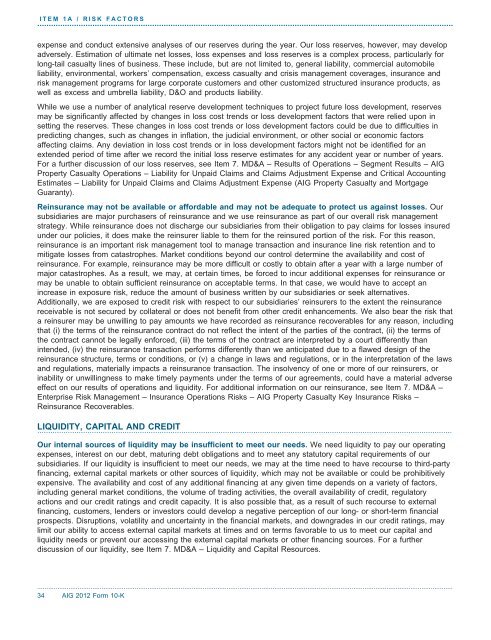Bring on tomorrow - AIG.com
Bring on tomorrow - AIG.com
Bring on tomorrow - AIG.com
You also want an ePaper? Increase the reach of your titles
YUMPU automatically turns print PDFs into web optimized ePapers that Google loves.
ITEM 1A / RISK FACTORS.....................................................................................................................................................................................expense and c<strong>on</strong>duct extensive analyses of our reserves during the year. Our loss reserves, however, may developadversely. Estimati<strong>on</strong> of ultimate net losses, loss expenses and loss reserves is a <strong>com</strong>plex process, particularly forl<strong>on</strong>g-tail casualty lines of business. These include, but are not limited to, general liability, <strong>com</strong>mercial automobileliability, envir<strong>on</strong>mental, workers’ <strong>com</strong>pensati<strong>on</strong>, excess casualty and crisis management coverages, insurance andrisk management programs for large corporate customers and other customized structured insurance products, aswell as excess and umbrella liability, D&O and products liability.While we use a number of analytical reserve development techniques to project future loss development, reservesmay be significantly affected by changes in loss cost trends or loss development factors that were relied up<strong>on</strong> insetting the reserves. These changes in loss cost trends or loss development factors could be due to difficulties inpredicting changes, such as changes in inflati<strong>on</strong>, the judicial envir<strong>on</strong>ment, or other social or ec<strong>on</strong>omic factorsaffecting claims. Any deviati<strong>on</strong> in loss cost trends or in loss development factors might not be identified for anextended period of time after we record the initial loss reserve estimates for any accident year or number of years.For a further discussi<strong>on</strong> of our loss reserves, see Item 7. MD&A – Results of Operati<strong>on</strong>s – Segment Results – <strong>AIG</strong>Property Casualty Operati<strong>on</strong>s – Liability for Unpaid Claims and Claims Adjustment Expense and Critical AccountingEstimates – Liability for Unpaid Claims and Claims Adjustment Expense (<strong>AIG</strong> Property Casualty and MortgageGuaranty).Reinsurance may not be available or affordable and may not be adequate to protect us against losses. Oursubsidiaries are major purchasers of reinsurance and we use reinsurance as part of our overall risk managementstrategy. While reinsurance does not discharge our subsidiaries from their obligati<strong>on</strong> to pay claims for losses insuredunder our policies, it does make the reinsurer liable to them for the reinsured porti<strong>on</strong> of the risk. For this reas<strong>on</strong>,reinsurance is an important risk management tool to manage transacti<strong>on</strong> and insurance line risk retenti<strong>on</strong> and tomitigate losses from catastrophes. Market c<strong>on</strong>diti<strong>on</strong>s bey<strong>on</strong>d our c<strong>on</strong>trol determine the availability and cost ofreinsurance. For example, reinsurance may be more difficult or costly to obtain after a year with a large number ofmajor catastrophes. As a result, we may, at certain times, be forced to incur additi<strong>on</strong>al expenses for reinsurance ormay be unable to obtain sufficient reinsurance <strong>on</strong> acceptable terms. In that case, we would have to accept anincrease in exposure risk, reduce the amount of business written by our subsidiaries or seek alternatives.Additi<strong>on</strong>ally, we are exposed to credit risk with respect to our subsidiaries’ reinsurers to the extent the reinsurancereceivable is not secured by collateral or does not benefit from other credit enhancements. We also bear the risk thata reinsurer may be unwilling to pay amounts we have recorded as reinsurance recoverables for any reas<strong>on</strong>, includingthat (i) the terms of the reinsurance c<strong>on</strong>tract do not reflect the intent of the parties of the c<strong>on</strong>tract, (ii) the terms ofthe c<strong>on</strong>tract cannot be legally enforced, (iii) the terms of the c<strong>on</strong>tract are interpreted by a court differently thanintended, (iv) the reinsurance transacti<strong>on</strong> performs differently than we anticipated due to a flawed design of thereinsurance structure, terms or c<strong>on</strong>diti<strong>on</strong>s, or (v) a change in laws and regulati<strong>on</strong>s, or in the interpretati<strong>on</strong> of the lawsand regulati<strong>on</strong>s, materially impacts a reinsurance transacti<strong>on</strong>. The insolvency of <strong>on</strong>e or more of our reinsurers, orinability or unwillingness to make timely payments under the terms of our agreements, could have a material adverseeffect <strong>on</strong> our results of operati<strong>on</strong>s and liquidity. For additi<strong>on</strong>al informati<strong>on</strong> <strong>on</strong> our reinsurance, see Item 7. MD&A –Enterprise Risk Management – Insurance Operati<strong>on</strong>s Risks – <strong>AIG</strong> Property Casualty Key Insurance Risks –Reinsurance Recoverables.LIQUIDITY, CAPITAL AND CREDIT..............................................................................................................................................................................................Our internal sources of liquidity may be insufficient to meet our needs. We need liquidity to pay our operatingexpenses, interest <strong>on</strong> our debt, maturing debt obligati<strong>on</strong>s and to meet any statutory capital requirements of oursubsidiaries. If our liquidity is insufficient to meet our needs, we may at the time need to have recourse to third-partyfinancing, external capital markets or other sources of liquidity, which may not be available or could be prohibitivelyexpensive. The availability and cost of any additi<strong>on</strong>al financing at any given time depends <strong>on</strong> a variety of factors,including general market c<strong>on</strong>diti<strong>on</strong>s, the volume of trading activities, the overall availability of credit, regulatoryacti<strong>on</strong>s and our credit ratings and credit capacity. It is also possible that, as a result of such recourse to externalfinancing, customers, lenders or investors could develop a negative percepti<strong>on</strong> of our l<strong>on</strong>g- or short-term financialprospects. Disrupti<strong>on</strong>s, volatility and uncertainty in the financial markets, and downgrades in our credit ratings, maylimit our ability to access external capital markets at times and <strong>on</strong> terms favorable to us to meet our capital andliquidity needs or prevent our accessing the external capital markets or other financing sources. For a furtherdiscussi<strong>on</strong> of our liquidity, see Item 7. MD&A – Liquidity and Capital Resources...................................................................................................................................................................................................................................34 <strong>AIG</strong> 2012 Form 10-K
















